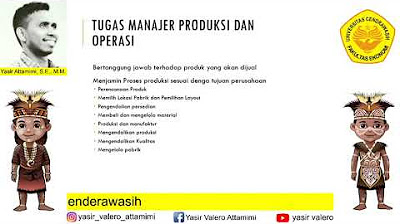[Part 1] Introduction to Operations Research - History, OR Today, Models, Structure, & Phases of OR
Summary
TLDRThis introductory lecture on operations research covers its history, current applications, and key mathematical techniques. The field applies scientific methods to solve complex problems in industries such as military, business, and healthcare. The lecture discusses models like iconic, analog, and symbolic models, as well as advanced models like heuristics and simulation. Key topics include linear programming, phases of an operations research study, and the structure of mathematical models. The session concludes with a preview of upcoming discussions on objective functions, decision variables, parameters, and constraints in part two.
Takeaways
- 📚 Operations research applies scientific methods to solve complex management and operational problems in various fields like industry, business, government, and defense.
- ⚙️ It originated during World War II when scientists were hired to optimize military operations, which later extended to industries for executive problem-solving.
- 🛠️ The first mathematical technique in operations research, the simplex method, was developed by George B. Dantzig, who solved unsolved mathematical problems that became his PhD dissertation.
- 🌍 Operations research is now used in diverse areas such as business, hospitals, financial institutions, city planning, transportation, and even crime investigations.
- ✈️ Different types of models in operations research include iconic models (like toy planes), analog models (such as graphs), and mathematical models (such as linear programs).
- 💡 Newer models include heuristics (rule-of-thumb solutions) and simulation models (digital representations of real systems).
- 📊 The main mathematical techniques used in operations research include linear programming, dynamic programming, non-linear programming, stochastic programming, and integer programming.
- 🔍 The phases of an operations research study involve defining the problem, constructing the model, solving the model, validating the solution, and implementing the final results.
- 🧮 Linear programs consist of an objective function, decision variables, parameters, and constraints, which form the structure of the mathematical model.
- 📝 Part 2 of the lecture will cover a detailed explanation of the elements in linear programs, including the objective function, decision variables, parameters, and constraints.
Q & A
What is the definition of operations research?
-Operations research is the application of scientific methods, techniques, and tools to solve complex problems involving the operations of a system, aiming to provide optimum solutions for decision-making in industry, business, government, and defense.
What is the historical origin of operations research?
-Operations research originated during World War II when a group of scientists in England were hired to optimize military operations, such as radar and bomber operations. The success of this research led to similar efforts in the United States and later expanded into industrial and business applications.
What are some of the modern-day applications of operations research?
-Today, operations research is used in a variety of fields, including business applications, hospitals, financial institutions, libraries, city planning, transportation systems, and even crime investigations.
What are iconic models in operations research?
-Iconic models are physical representations or prototypes of real-world problems. For example, a toy plane is an iconic model of a real plane.
What is a heuristic model in operations research?
-Heuristic models are rule-of-thumb methods or innovative techniques that are not strictly based on formal mathematical approaches but may be useful in solving certain problems. An example is scheduling tasks based on shortest processing time.
What are the main phases of an operations research study?
-The main phases of an operations research study are: 1) defining the problem, 2) constructing the model, 3) solving the model, 4) validating the model, and 5) implementing the final results.
What is the simplex method, and who developed it?
-The simplex method is a mathematical technique used in linear programming to find the best solution to a problem. It was developed by George B. Dantzig as part of his PhD dissertation.
What is a mathematical model in operations research?
-A mathematical model is a symbolic representation of a real system through mathematical equations and functions. An example is a linear program (LP), where the system is modeled using variables, objective functions, and constraints.
What are the key components of a linear program?
-A linear program consists of the following key components: 1) objective function, 2) decision variables, 3) parameters, and 4) constraints.
Why is model validation important in operations research?
-Model validation is important because it ensures that the solution derived from the model is accurate and applicable to the real-world system. This is often done by implementing the solution in a prototype system to check its effectiveness.
Outlines

Cette section est réservée aux utilisateurs payants. Améliorez votre compte pour accéder à cette section.
Améliorer maintenantMindmap

Cette section est réservée aux utilisateurs payants. Améliorez votre compte pour accéder à cette section.
Améliorer maintenantKeywords

Cette section est réservée aux utilisateurs payants. Améliorez votre compte pour accéder à cette section.
Améliorer maintenantHighlights

Cette section est réservée aux utilisateurs payants. Améliorez votre compte pour accéder à cette section.
Améliorer maintenantTranscripts

Cette section est réservée aux utilisateurs payants. Améliorez votre compte pour accéder à cette section.
Améliorer maintenantVoir Plus de Vidéos Connexes

Pesquisa Operacional Aula01

Pengantar Demografi #Pertemuan1 Part 3 END: SUMBER DATA KEPENDUDUKAN, PERBANDINGAN BEBERAPA NEGARA

Lecture 01 : Introduction to Drilling Technology

Kuluah Riset Operasional 1 - Konsep Dasar Riset Operasional

Materi kuliah Pengantar Bisnis, Pertemuan Ke-5

Lecture 4: Current, Voltage and Resistance l (General Physics 2)
5.0 / 5 (0 votes)
